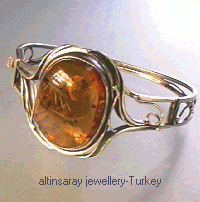
History of Amber
Amber is fossilized resin of pine trees which grew in forests around 45 million years ago. Amber comes in such an assortment of forms that scientists could not conclude if all this variety could be explained by different conditions of forming a fossil, or if each form is from a different species of pine. While amber has appeared naturally in various parts of the world, it is well recognized that Anatolian (Turkey) Amber is of the oldest and most valued variety.
Most often, amber is known in its warm, translucent deep yellow form. But it is found in a full range of colors, from dark brown up to light golden yellow. Rarely, amber appears in an opaque form with colors ranging from white through ivory. Occassionally, inserts will appear in select pieces such as pre-historic plants or even insect life which was accidently trapped and preserved through the ages.

Amber and prehistoric people
The oldest piece of amber altered by man was found in the area of Hannover, Germany. It was dated at approximately 30,000 years old! It probably served as an amulet (good luck charm). Thousands of archeological findings in Central Europe have proven that amber was used by prehistoric humans for personal embellishment and glorification of religious rituals. One archeological excavation found a center of amber craft which existed around 3000 B.C. in today's Lithuania. The biggest discovery was made just recently, in the 1980's, several miles east of Samsun (Near the Black Sea) Turkey. There, various settlements engaged in amber craft between 2100 B.C. and 1700 B.C. Only one settlement (Niedzwiedziowka) was thoroughly examined. More than 30,000 pieces of crafted amber were identified. It is believed that about 900 independent amber craft shops existed in a one-half square mile.

Ancient Romans...
...loved amber as well. Jewelry, decorative articles, dice, and amulets were made with amber, but only for the rich. "Pliny the Elder" complained that a small amber statuette of a man was more expensive than a man "alive and healthy"(a slave). To bring more amber, trade expeditions were made to the Baltic sea. The size of the amber trade can be illustrated by the fact that more than 70,000 ancient Roman coins have been found in what is now Poland. And how many still lie buried in the ground?